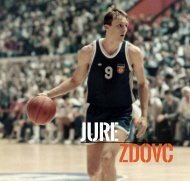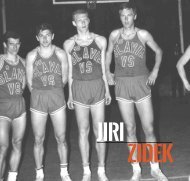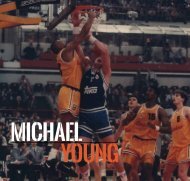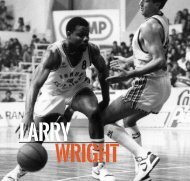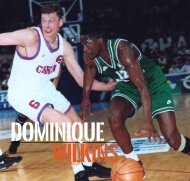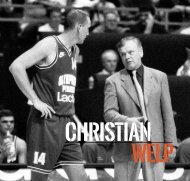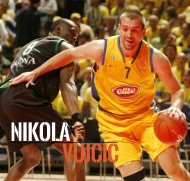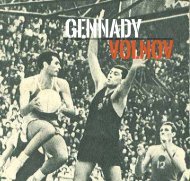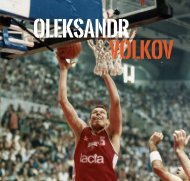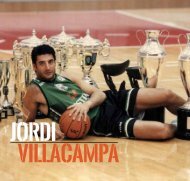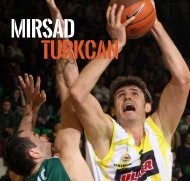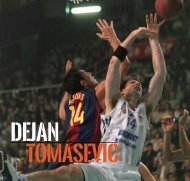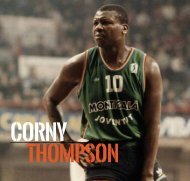101 Greats of European Basketball
Create successful ePaper yourself
Turn your PDF publications into a flip-book with our unique Google optimized e-Paper software.
Vladimir Stankovic<br />
– his great weapon was rebounding. Korac was able<br />
to fight for the ball with men taller than himself. The<br />
<strong>of</strong>ficial stat sheet <strong>of</strong> the Yugoslav national team shows<br />
that Korac shares the top spot with Kresimir Cosic in<br />
this category; each averaged 7 rebounds per game.<br />
Korac’s best friend and godfather, Dragutin Tosic, a<br />
school friend and teammate at OKK, told the story that<br />
in his first game as a junior, they defeated Pancevo 33-<br />
28 as Korac scored ... 33 points! In 1956, Korac made his<br />
debut in the OKK first team and over the following eight<br />
years he was the league’s leading scorer seven times. His<br />
averages were quite impressive: in 1957 - 29.1 points; in<br />
1958, 35.2; in 1960, 37.0; in 1962, 30.5; in 1963, 34.5; in<br />
1964, 26.3; and in 1965, 31.6. With OKK, Korac won four<br />
Yugoslav League titles and three domestic cups. His first<br />
coach at the junior level was Dragutin Glisic, and in the<br />
first senior team, his coach was Borislav Stankovic, the<br />
future secretary general <strong>of</strong> FIBA.<br />
Korac also played football – his brother Djordje, a<br />
sculptor, was the goalkeeper at Radnicki Belgrade –<br />
handball and athletics, where he excelled in the high<br />
jump. Korac’s great goal was to jump higher than his<br />
own height, 1.93 meters – and accomplished that.<br />
During his military service, Korac was the champion<br />
in that discipline. He was also the best chess player<br />
among his mates. His coaches and teammates always<br />
said that at first sight, Korac seemed like a slow and<br />
clumsy player, like he was not interested in what was<br />
happening around him. This impression fooled many<br />
<strong>of</strong> the players that guarded him because he was the<br />
opposite: fast with the ball, strong, left-handed, a good<br />
jumper. His famous left hand was precise, but he shot<br />
his free throws in a very peculiar manner by that era’s<br />
standards and virtually non-existent today: “granny<br />
style”, underhand, with both hands down. He held the<br />
ball between his legs, one hand on each side. And he<br />
hardly missed.<br />
Free throws: 100 <strong>of</strong> 100 on TV<br />
After leaving Yugoslavia, Korac played in Belgium,<br />
where he was the star <strong>of</strong> national champion Standard<br />
Liege. In a live television interview in French – a language<br />
he learned in three months – they asked him how many<br />
free throws he would make out <strong>of</strong> 100 attempts. His<br />
answer was “about 80.” The host <strong>of</strong> the show asked immediately,<br />
“Can you prove that?” When Korac said that<br />
he could, a curtain opened and a real basket appeared.<br />
Korac accepted the challenge, took <strong>of</strong>f his jacket and<br />
shirt, and with his dress pants and shoes on, started<br />
scoring – 10, 25, 47, 62, 88, 99 ... and 100! No misses!<br />
During his time in Belgium, the president <strong>of</strong> Standard<br />
gave him a car, a new model Volkswagen. Korac<br />
loved to drive, even though it’s been said that he was<br />
not very good behind the wheel. In the summer <strong>of</strong> 1969,<br />
after spending a season playing for Arqua Petrarca in<br />
Italy, where <strong>of</strong> course he was the best scorer in the<br />
league, Korac drove to Belgrade in this car. The national<br />
team had a friendly game scheduled in Sarajevo and he<br />
wanted to make the trip in his car. On June 1, 1969, Yugoslavia<br />
beat Bosnia and Herzegovina 131-93 behind<br />
35 points by Korac. Nobody would have even imagined<br />
that those were his last points. The following day, June<br />
2, after breakfast, two cars started for Belgrade from<br />
Sarajevo. The first one was occupied by Coach Ranko<br />
Zeravica and his wife Zaga, the second by Radivoj Korac.<br />
Just a few kilometers outside <strong>of</strong> Sarajevo, near the<br />
town <strong>of</strong> Kamenica, Korac tried to pass another car while<br />
driving uphill. The other car wouldn’t let him. In the opposite<br />
lane, a truck appeared. Ranko and Zaga Zeravica<br />
saw the collision in their rearview mirror. They were the<br />
168<br />
169



